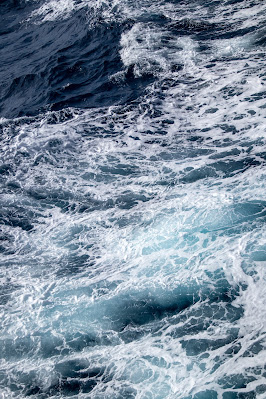Our notice before we turned north and left the icebergs astern stated: "The Drake may not be quite as kind to us as on the way down....but, what an opportunity to understand what all the fuss is about. Maybe put on the (scopolamine) patch tonight the 27th before sleeping. Be sure that breakable items are carefully stowed before retiring this evening. The 28th should start out fairly gentle, and reveal itself as the day goes on. Often referred to as the "Drake Tax", it must be paid for the astounding beauty of the icy continent."
Seas the morning of the 28th.
"The Drake Passage is considered one of the most treacherous voyages for ships to make. Currents at this latitude meet no resistance from any landmass, and waves can top 40 feet, hence it reputation as "the most powerful convergence of seas. As the Drake Passage is the narrowest passage around Antarctica, its existence and shape strongly influence the circulation of water around Antarctica and the global oceanic circulation, as well as the global climate" ~Wikipedia
The current in the Drake is west to east. On our trip south, we had a following wind and the influence of a High pressure area. There were waves and wind but our passage was relatively calm due to the stabilizing ability of the Resolution. On our way back north, a Low pressure system, with gale force winds, slammed up against the high. Think of all the lines running counterclockwise (cyclonic) on our evening weather news, converging into a near solid black line. Looking at "Windy" website graphics, we knew we were in for quite a ride. With the wind and prevailing waves from the west the, Port (west) side cabins of the boat received extra precautions. Deck 4 windows were covered with wooden inserts and on Deck 5 and 6, all dividers between cabin decks were removed along with all tables and chairs.
Captain Marvin steered us on a NE course to skirt the worst of the storm as long as possible. The night of the 27th and morning of the 28th were only slightly worse than our southerly passage. My deck table and chairs were strapped down but, I decided to hang my hammock anyway to enjoy the sway - abet limited by the table and a chair. CJ came in later that morning to take it down. I had her take my picture before we did.













.jpg)




